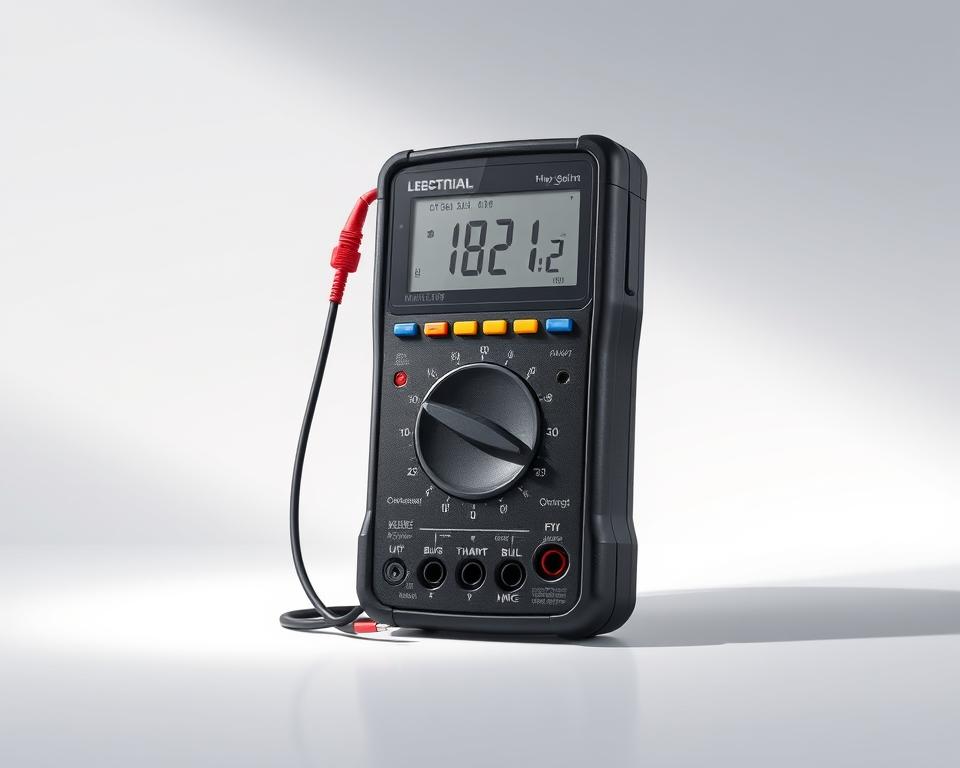Multimeter Applications: Essential Functions Clarified
The typical multimeter can quantify up to 20V in voltage levels. Yet many endeavors, notably in modern creativity and electronics, use less than 200mA of current. This reality underscores the critical role multimeters play in electronic diagnostics and problem resolution. Realizing how to operate a multimeter is crucial, not just for experts and specialists, but also for students examining electrical concepts.
Multimeters are indispensable in their versatility, offering precise measurements of voltage, current, and resistance. This piece will investigate the various roles and functions of a Cen-Tech 7-function digital multimeter. It aims to provide you with the understanding to successfully use this essential tool in your electrical experiments and projects.
Principal Learnings
- Multimeters are key devices for gauging voltage, current, and resistance.
- Understanding multimeter functions is essential for successful troubleshooting.
- Digital multimeters are popular for their clarity and exactness in measurements.
- Safety protocols are critical when employing a multimeter for electronic assessments.
- Continuity assessment is an important capability for inspecting wiring integrity.
- Selecting the proper multimeter can substantially influence your testing efficiency.
Beginnings to Multimeters
A multimeter is vital for diagnosing electronic faults and guaranteeing devices function properly. It measures various electrical characteristics, indispensable for both experts and enthusiasts.
Definition of a Multimeter?
A multimeter combines instruments to assess electrical potential, current, and resistance. This assists considerably in solving electrical issues. Available in traditional and digital versions, multimeters are vital. Analog models use a needle and scale for readings, whereas digital ones display values on a display. They test wall outlets, batteries, and various gadgets.
Significance of Multimeter in Circuit Diagnostics
In electrical testing, the role of a multimeter is crucial. It verifies circuit integrity and detects issues in various environments. For instance, in the car industry, it examines battery voltage and sensors. It also confirms industrial machinery functions seamlessly, avoiding expensive failures.
Multimeters, crucial for testing, assess AC and DC voltage, current, and resistance. Their capacity to manage diverse tasks makes them irreplaceable for both simple and advanced projects.
Categories of Multimeters
Understanding the various types of multimeters is vital for successful electrical testing. They fall into two main classes: analog and digital multimeters. Each offers distinct features and perks. Therefore, selecting the suitable type is determined by your individual demands and preferences.
Traditional Multimeters
Analog multimeters feature a dial indicator and dial display. They are ideal for observing fast-changing measurements. Their design enables users to see changes as they transpire. Analog devices feature a sensitivity range typically between 1,000 to 50,000 ohms per volt, with the peak sensitivity reaching 20K Ω/V. This established them as popular for broadcast engineers in the mid-century period.

Digital Multimeters
Due to their precision and performance, digital multimeters have become well-regarded. Their LCDs display readings clearly and can reveal up to four digits. They can gauge various attributes like electrical potential and thermal readings. Furthermore, high-end models provide auto-ranging, recording data, and remote features. This renders them well-suited for complex tasks in fields like car troubleshooting and renewable energy.
Comparison of Traditional and Electronic Multimeters
Choosing between analog and digital multimeters is contingent upon your particular requirements and financial plan. The table below outlines their primary distinctions:
| Characteristic | Traditional Multimeters | Electronic Multimeters |
|---|---|---|
| Screen | Pointer indicator on dial | LCD screen (LCD) |
| Precision | Adequate, but somewhat lower in precision | High precision and clarity |
| Reaction Time | Rapid response to fluctuations | Relies on sample frequency |
| Uses | Ideal for fast-shifting values | Multifunctional, used across multiple sectors |
| Price | Usually more affordable | Varies widely, but can be higher |
Although both multimeter types are crucial for electrical testing, digital multimeters’ exactness and capability have established their popularity among users in both home and industrial spaces.
Components of a Multimeter
Grasping the essential parts of a multimeter is vital for its efficient use. It comprises multiple core components, each with a specific role. The visual panel delivers measurements, while the dial control enables users to alternate between functions like voltage, current, and resistance. Probes link the device to the circuit being examined, representing another crucial feature.
Essential Components and Their Operations
The key elements of a multimeter are segmented into:
- Visual Interface: Exhibits readings in real-time for easy comprehension.
- Selection Knob: Enables users to pick the mode, including voltage, current, or resistance functions.
- Connectors: Typically three, but some models have four for attaching various probes.
- Measurement Leads: Critical for linking the multimeter to electrical systems, with the red probe for positive and black for ground connections.
Comprehending Multimeter Probes
Probes play a fundamental role in multimeter function. They are offered in various types, such as standard or alligator clips. The red probe is used for testing electrical potential or resistance; the black functions as a ground. Using alligator clips simplifies tasks with several components, improving measurement precision and productivity.
Mechanics of the Selection Knob
The selection knob is essential for maneuvering through the device’s capabilities. By rotating the knob, users can toggle among AC and DC voltage assessments, current monitoring, or resistance testing. Choosing the appropriate setting is critical for precise readings. Users must take precautions with the range setting to avert device damage or erroneous readings.
Functions of a Multimeter
For anyone involved in electrical testing, knowing the multimeter’s capabilities is crucial. These devices deliver essential measurements for properly examining electrical parts. They assess voltage, assess current, and check resistance, rendering them indispensable for both commercial applications and DIY projects.
Gauging AC and DC Voltage
Measuring both AC and DC voltage is a fundamental function of multimeters. They deliver remarkable exactness, with the capacity to discern slight changes. This is vital for guaranteeing that electrical devices run safely within their voltage limits.
Testing Current Measurement
Current measurement is more involved than voltage. You must disrupt the circuit path where you want to measure, as the multimeter is connected in series. Choose the proper range, marked in amps or milliamps. Securely affix the multimeter probes between the discontinuities of the circuit.
Understanding Resistance Measurement
Testing component functionality, like resistors and capacitors, is performed via resistance measurement. Multimeters can measure resistance up to multiple megaohms, which is key for evaluating circuit integrity and executing continuity tests.
Continuity Testing Capabilities
Continuity testing is vital for troubleshooting. It utilizes audio signals or display cues to indicate electrical connections. This secures that circuits perform correctly, assisting with streamlined fault finding.
| Function | Analog Multimeters | Digital Multimeters |
|---|---|---|
| Voltage Measurement | Measures AC and DC voltage with remarkable exactness | Evaluating power supply in devices |
| Current Measurement | Assesses electrical flow in circuits | Checking battery voltage and sensor functionality |
| Resistance Measurement | Tests the operation of circuit components | Ensuring resistors and diodes are within tolerance levels |
| Continuity Testing | Assesses electrical connections | Assessing circuit integrity |
Operating a Multimeter Safely and Effectively
Understanding how to handle a multimeter is essential for anyone engaged in electrical systems. Proper procedures ensure safety and precise readings. When assessing voltage, current, or resistance, each step requires particular safeguards.
Basic Safety Measures
Acquiring safety precautions before using a multimeter is critical. Your multimeter should be certified for your operating conditions. Unfortunately, over 30% of electricians use inadequately rated tools, endangering safety. To work securely, always confirm the multimeter is properly configured before connecting probes.
Steps for Measuring Voltage
Measuring voltage necessitates meticulousness. First, select the appropriate multimeter range for the voltage, AC or DC. Insert the probes into the right ports: the common and voltage-specific ones. Then, affix the probes precisely to the circuit.
How to Measure Current
Current measurement is more intricate than voltage. You must interrupt the circuit path where you want to measure, as the multimeter is connected in series. Choose the proper range, marked in amperes or milliamps. Securely connect the multimeter probes between the break points of the circuit.
Steps for Testing Resistance
To accurately test resistance, detach the component in question. Switch the multimeter to resistance mode, then attach the probes to the component. A matching reading means that the component works well; otherwise, it might be defective. This safety consideration prevents multimeter damage and secures accurate electrical flow analysis.
Typical Uses of Multimeters
Multimeters are indispensable in both industrial and residential environments for a variety of functions. They excel in diagnosing electrical circuits, rendering them priceless. These devices are crucial in identifying and correcting electrical problems, securing systems work as they should.
Troubleshooting Electrical Issues
Multimeters primarily are used to detect electrical circuit issues. Technicians and DIY enthusiasts depend on them to locate problems. By measuring voltage, current, and resistance, they detect faulty parts, securing proper operation.
Testing Batteries and Power Sources
Testing batteries is a crucial application for multimeters. They measure voltage to determine automotive or household battery energy level. This helps users know if a battery works well or needs changing, optimizing energy management.
Assessing Circuit Integrity
For safety and performance, verifying circuit integrity is essential. Multimeters assess this by measuring continuity and resistance. They spot issues such as broken wires or defects, prompting timely fixes. Overall, multimeters enhance both the safety of installations and diagnostic processes.
Selecting the Suitable Multimeter for Your Needs
Selecting the appropriate multimeter improves your productivity in electrical testing. Key factors to consider include precision, measurement options, mobility, and user-friendliness. Unlike analog meters, digital multimeters excel in functionality, favored by technicians and hobbyists.
Factors to Consider
Essential factors in choosing a multimeter include:
- Precision: Digital multimeters deliver high precision, detecting changes down to 1 millivolt.
- Range Options: Choose models that support multiple electrical metrics like voltage, current, and resistance.
- Compactness: Select lightweight, easy-to-carry designs for portable use.
- Ease of Use: Auto-ranging and illuminated screens enhance a better user experience.
Favored Options: Cen-Tech 7 Function Digital Multimeter
The Cen-Tech 7 Function Digital Multimeter is recognized for its versatility and cost-effectiveness. It brings together vital features that appeal to both beginners and professionals. Additionally, its auto-ranging function facilitates measurements, streamlining task execution.
This model’s count capacity reaches up to 20,000, promising accurate measurements for a variety of electrical jobs. It performs exceptionally in troubleshooting, automotive tests, and battery checks. Its mix of essential features and user-friendly design makes the Cen-Tech 7 Function Digital Multimeter a top pick for a new investment.
The Bottom Line
Grasping multimeter functions is key for those engaged in electrical tasks. We’ve encapsulated multimeter roles, highlighting their value in testing and safety. Their precision in measuring voltage, current, and resistance is invaluable. Thus, multimeters are crucial for both professionals and hobbyists.
Multimeters exceed mere measurements. They deliver advanced functionalities like data capture and wireless connections. These features enable wide-ranging functions, from car diagnostics to exploiting renewable energy. Additionally, capabilities for continuity and frequency checks are instrumental in detecting defects, securing systems operate seamlessly.
Armed with this understanding, individuals can skillfully employ their multimeter proficiency for accurate fault detection and improving safety protocols. They can also boost the efficiency of electrical setups and servicing. Essentially, multimeters’ flexibility renders them irreplaceable in achieving accuracy in electrical jobs.
Common Inquiries
What are the primary functions of a multimeter?
A multimeter primarily measures voltage (AC and DC), current, and resistance. It also conducts continuity tests. These operations are essential for detecting electrical faults and assessing system integrity.
What factors determine whether to select an analog or digital multimeter?
Choosing between analog and digital multimeters is based on your requirements. Analog types are excellent at showing swift changes in value. In contrast, digital models provide accurate digital outputs. This renders them favored for daily tasks.
What safety precautions should I take when using a multimeter?
When using a multimeter, always set the proper range before connecting. Avoid touching live wires when assessing current. Also, remove components before resistance tests to avoid inaccurate readings.
Can a multimeter test batteries?
Yes, battery testing is a typical function for multimeters. They assess voltage to indicate charge level. This ensures that your power sources are trustworthy for various needs.
What is continuity testing, and why is it important?
Continuity testing checks electrical connections in a circuit using a multimeter. It’s essential for finding and fixing breaks. This ensures that your electrical setups operate as intended.
What parts does a multimeter usually consist of?
A multimeter typically comprises a reading display, a mode dial, probe ports, and the probes. The probes connect to the circuit being analyzed.
How does the Cen-Tech 7 Function Digital Multimeter measure up against other options?
The Cen-Tech 7 Function Digital Multimeter is user-friendly and delivers flexible features, including auto-ranging. It’s affordably priced, making it a wise selection for professionals and DIYers.

